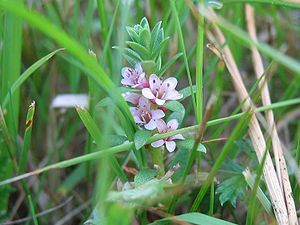Beach milkweed
| Beach milkweed | ||||||||||||
|---|---|---|---|---|---|---|---|---|---|---|---|---|

Beach milkweed ( glaux maritima ) |
||||||||||||
| Systematics | ||||||||||||
|
||||||||||||
| Scientific name of the genus | ||||||||||||
| Glaux | ||||||||||||
| L. | ||||||||||||
| Scientific name of the species | ||||||||||||
| Glaux maritima | ||||||||||||
| L. |
The beach milkweed ( Glaux maritima ) is the only plant species of the genus Glaux in the subfamily of the myrsine family (Myrsinoideae) within the primrose family (Primulaceae).
description
The beach milkweed is a hibernating green, perennial herbaceous plant that only reaches heights of about 3 to 25 cm. The creeping up rising stem forms roots at the nodes ( Nodien ). The closely spaced leaves are thick, about 4 to 15 mm long, 1.5 to 3.5 (rarely up to 5) mm wide and elongated-lanceolate or elliptical in shape. The lower leaves are opposite, while the upper leaves are alternate. The leaf margin is smooth.
The almost sessile flowers are individually in the leaf axils. The hermaphrodite, radial symmetry , five-fold flowers have a diameter of 3 to 6 mm. There are no petals . For this, five petals -like, pink-colored, only extremely rarely white-colored sepals are formed; they are 1.5 to 2 mm wide. The stamens are slightly shorter than the sepals. The stylus is about as long as the stamens.
The five-compartment capsule fruit has a diameter of 2.5 to 3 mm. The triangular seeds are reddish brown and about 1.2 mm long.
The number of chromosomes is 2n = 30.
ecology
The beach milkweed blooms between May and August in fairly moist, salty places. It survives the winter as a hemicryptophyte . It forms underground runners ( stolons ) through the formation of secondary beets, via which it can also reproduce vegetatively. Its pre-female flowers are mostly pollinated by short-nosed insects.

Occurrence
The beach milkweed occurs naturally in the entire northern hemisphere in the meridional to boreal climatic zone . Here, however, it only grows littoral on the coasts and in inland salt areas , where it is a typical pointer plant . Its main distribution is in northern Europe and northern Asia. It is found in Europe, North America, the temperate zones of Asia, and Pakistan.
The beach milkweed grows preferentially in very moist, salty areas that can also be periodically flooded. Typically these are sections of the coast. In inland areas this plant species is therefore extremely rare in natural or man-made salt marshes. Due to the increasing anthropogenic influence, stocks are declining, especially inland. That is why the beach milkweed is also on the red list in the southern federal states. In Rhineland-Palatinate and Baden-Württemberg, it is even considered to be extinct. In North Rhine-Westphalia and Berlin it is threatened with extinction. In Austria, the beach milkweed is found only in Zwingendorf (Lower Austria).
The plant has its main occurrence in salt plant corridors and is characteristic of the association Armerion maritimae and the order Glauco-Puccinellietalia. It often grows together with beach cloves , swaths of salt , bay rushes , beach tridents and salt bungles .
According to the Ellenberg pointer values , it is a half-shade to half-light plant (L6), shows moderate warmth or warmth (T6), grows in damp locations (F6), shows moderate nitrogen abundance (N5) and tolerates a high salt content (S7).
Taxonomy
The beach-milkweed ( Glaux maritima L. ) is due to molecular characteristics as Lysimachia maritima (L.) Galasso, Banfi & Soldano in the genus Lysimachia asked, but usually more than in the Federal Republic of Germany Glaux maritima L. out.
literature
- Qiming Hu, Sylvia Kelso: Primulaceae. In: Flora of China. Glaux maritima - online.
- Flora of Pakistan : Glaux maritima - online.
- Erich Oberdorfer : Plant-sociological excursion flora for Germany and neighboring areas. 8th edition. Verlag Eugen Ulmer, Stuttgart 2001, ISBN 3-8001-3131-5 , p. 743.
Individual evidence
- ↑ a b Erich Oberdorfer : Plant-sociological excursion flora for Germany and neighboring areas . With the collaboration of Angelika Schwabe and Theo Müller. 8th, heavily revised and expanded edition. Eugen Ulmer, Stuttgart (Hohenheim) 2001, ISBN 3-8001-3131-5 , pp. 743 .
- ^ A b Glaux in the Germplasm Resources Information Network (GRIN), USDA , ARS , National Genetic Resources Program. National Germplasm Resources Laboratory, Beltsville, Maryland. Retrieved October 4, 2017.
- ↑ G. Hao, YM Yuan, CM Hu, XJ Ge, NX Zhao: Molecular phylogeny of Lysimachia (Myrsinaceae) based on chloroplast trnL – F and nuclear ribosomal ITS sequences. In: Molecular phylogenetics and evolution. 31 (1), 2004, pp. 323-339. doi: 10.1016 / S1055-7903 (03) 00286-0
Web links
- Beach milkweed. In: FloraWeb.de.
- Beach milkweed . In: BiolFlor, the database of biological-ecological characteristics of the flora of Germany.
- Thomas Meyer: Dairy herb data sheet with identification key and photos at Flora-de: Flora von Deutschland (old name of the website: Flowers in Swabia )

